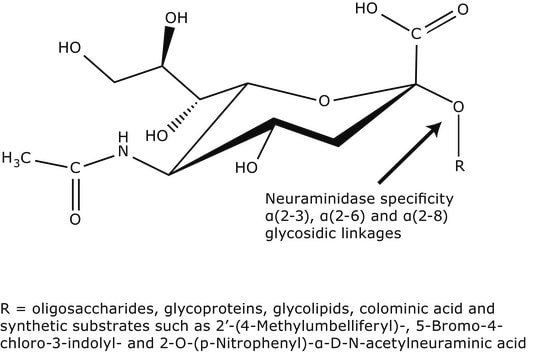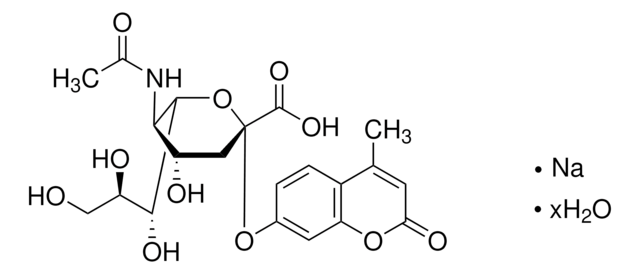10269611001
Roche
Neuraminidase (Sialidase)
from Arthrobacter ureafaciens
Sinónimos:
PCR, taq
Iniciar sesiónpara Ver la Fijación de precios por contrato y de la organización
About This Item
Productos recomendados
origen biológico
bacterial (Arthrobacter ureafaciens)
Nivel de calidad
formulario
solution
actividad específica
~25 units/mg protein
envase
pkg of 1 U (100 μl)
fabricante / nombre comercial
Roche
pH óptimo
5.0-5.5
temp. de almacenamiento
2-8°C
Descripción general
Neuraminidase hydrolyzes terminal N- or O-acylneuraminic acids which are α2,3-, α2,6-, or α2,8-linked (rate: α2,6 > α2,3 > α2,8) to oligosaccharides, polysaccharides, mucopolysaccharides, glycoproteins, and glycolipids. Noteworthy, for the hydrolysis of glycolipids, the presence of a detergent is necessary. Because of the broad substrate specificity, the enzyme is very well suited for the complete removal of sialic acids from glycoconjugates of a wide variety of biological materials.
Especificidad
Cleaves terminal sialic-acid residues that are α2,3-, α2,6-, or α2,8-linked to Gal, GlcNAc, GalNAc, AcNeu, GlcNeu, oligosaccharides, glycolipids, or glycoproteins. Relative rate of cleavage is α2,6 >α2,3 >α2,8, determined on bonds in tri- and tetrasaccharides.
Aplicación
- cell surface lectin array analysis.
- hemagglutination assays.
- cell adhesion assay.
For the hydrolysis of glycolipids, the presence of a detergent is necessary. Because of the broad substrate specificity, the enzyme is very well suited for the complete removal of sialic acids from glycoconjugates of a wide variety of biological materials.
Neuraminidase has been used for the:
- detection of the cell surface glycosylations in human anaplastic large cell lymphoma cells
- release of sialic acid from cells
- antibody-overlay lectin microarray
Propiedades físicas
This product is a mixture of isoenzymes (L, M1, M2 and S) with the following molecular weight values: ~ 52 kDa, 66 kDa and 88 kDa.
Forma física
Solution in 10 mM sodium phosphate, 0.1% Micr-O-Protect (w/v), 0.25 mg/ml bovine serum albumin, pH 7
Nota de preparación
Working concentration: Enzyme/substrate ratio should be in the range of 0.04 U/25-80 μg.
Otras notas
For life science research only. Not for use in diagnostic procedures.
Palabra de señalización
Warning
Frases de peligro
Consejos de prudencia
Clasificaciones de peligro
Skin Sens. 1
Clase de riesgo para el agua (WGK)
nwg
Punto de inflamabilidad (°F)
does not flash
Punto de inflamabilidad (°C)
does not flash
Certificados de análisis (COA)
Busque Certificados de análisis (COA) introduciendo el número de lote del producto. Los números de lote se encuentran en la etiqueta del producto después de las palabras «Lot» o «Batch»
¿Ya tiene este producto?
Encuentre la documentación para los productos que ha comprado recientemente en la Biblioteca de documentos.
Los clientes también vieron
A high-throughput capillary isoelectric focusing immunoassay for fingerprinting protein sialylation.
Lam Raga Anggara Markely et al.
Biotechnology progress, 32(1), 235-241 (2015-11-21)
The serum half-life, biological activity, and solubility of many recombinant glycoproteins depend on their sialylation. Monitoring glycoprotein sialylation during cell culture manufacturing is, therefore, critical to ensure product efficacy and safety. Here a high-throughput method for semi-quantitative fingerprinting of glycoprotein
Sialylation by ??galactoside ??2,6?sialyltransferase and N?glycans regulate cell adhesion and invasion in human anaplastic large cell lymphoma
Suzuki O, et al.
International Journal of Oncology, 46(3), 973-980 (2015)
Tomonori Kaifu et al.
The Journal of experimental medicine, 218(12) (2021-11-25)
Dendritic cell immunoreceptor (DCIR) is a C-type lectin receptor with a carbohydrate recognition domain and an immunoreceptor tyrosine-based inhibitory motif. Previously, we showed that Dcir-/- mice spontaneously develop autoimmune enthesitis and sialadenitis, and also develop metabolic bone abnormalities. However, the
Cellular entry of the porcine epidemic diarrhea virus
Li W, et al.
Virus Research, 226, 117-127 (2016)
C K Liu et al.
Journal of virology, 72(6), 4643-4649 (1998-05-30)
The human JC polyomavirus (JCV) is the etiologic agent of the fatal central nervous system (CNS) demyelinating disease progressive multifocal leukoencephalopathy (PML). PML typically occurs in immunosuppressed patients and is the direct result of JCV infection of oligodendrocytes. The initial
Protocolos
Neuraminidase (Sialidase) Protocol
Nuestro equipo de científicos tiene experiencia en todas las áreas de investigación: Ciencias de la vida, Ciencia de los materiales, Síntesis química, Cromatografía, Analítica y muchas otras.
Póngase en contacto con el Servicio técnico







